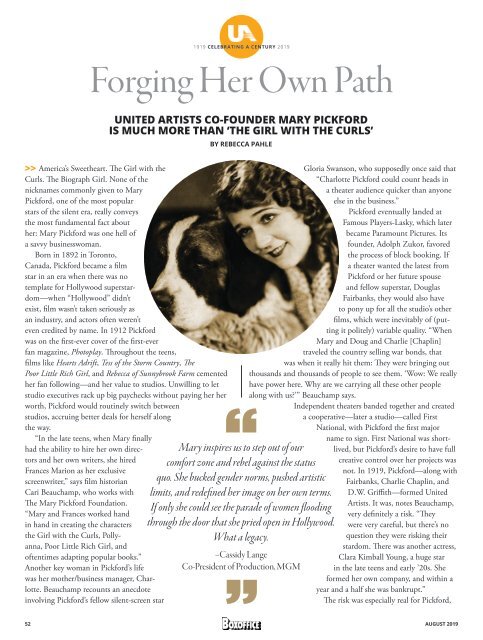Boxoffice - August 2019
The Official Magazine of the National Association of Theatre Owners
The Official Magazine of the National Association of Theatre Owners
Create successful ePaper yourself
Turn your PDF publications into a flip-book with our unique Google optimized e-Paper software.
1919 CELEBRATING A CENTURY <strong>2019</strong><br />
Forging Her Own Path<br />
UNITED ARTISTS CO-FOUNDER MARY PICKFORD<br />
IS MUCH MORE THAN ‘THE GIRL WITH THE CURLS’<br />
BY REBECCA PAHLE<br />
>> America’s Sweetheart. The Girl with the<br />
Curls. The Biograph Girl. None of the<br />
nicknames commonly given to Mary<br />
Pickford, one of the most popular<br />
stars of the silent era, really conveys<br />
the most fundamental fact about<br />
her: Mary Pickford was one hell of<br />
a savvy businesswoman.<br />
Born in 1892 in Toronto,<br />
Canada, Pickford became a film<br />
star in an era when there was no<br />
template for Hollywood superstardom—when<br />
“Hollywood” didn’t<br />
exist, film wasn’t taken seriously as<br />
an industry, and actors often weren’t<br />
even credited by name. In 1912 Pickford<br />
was on the first-ever cover of the first-ever<br />
fan magazine, Photoplay. Throughout the teens,<br />
films like Hearts Adrift, Tess of the Storm Country, The<br />
Poor Little Rich Girl, and Rebecca of Sunnybrook Farm cemented<br />
her fan following—and her value to studios. Unwilling to let<br />
studio executives rack up big paychecks without paying her her<br />
worth, Pickford would routinely switch between<br />
studios, accruing better deals for herself along<br />
the way.<br />
“In the late teens, when Mary finally<br />
had the ability to hire her own directors<br />
and her own writers, she hired<br />
Frances Marion as her exclusive<br />
screenwriter,” says film historian<br />
Cari Beauchamp, who works with<br />
The Mary Pickford Foundation.<br />
“Mary and Frances worked hand<br />
in hand in creating the characters<br />
the Girl with the Curls, Pollyanna,<br />
Poor Little Rich Girl, and<br />
oftentimes adapting popular books.”<br />
Another key woman in Pickford’s life<br />
was her mother/business manager, Charlotte.<br />
Beauchamp recounts an anecdote<br />
involving Pickford’s fellow silent-screen star<br />
Mary inspires us to step out of our<br />
comfort zone and rebel against the status<br />
quo. She bucked gender norms, pushed artistic<br />
limits, and redefined her image on her own terms.<br />
If only she could see the parade of women flooding<br />
through the door that she pried open in Hollywood.<br />
What a legacy.<br />
–Cassidy Lange<br />
Co-President of Production, MGM<br />
Gloria Swanson, who supposedly once said that<br />
“Charlotte Pickford could count heads in<br />
a theater audience quicker than anyone<br />
else in the business.”<br />
Pickford eventually landed at<br />
Famous Players-Lasky, which later<br />
became Paramount Pictures. Its<br />
founder, Adolph Zukor, favored<br />
the process of block booking. If<br />
a theater wanted the latest from<br />
Pickford or her future spouse<br />
and fellow superstar, Douglas<br />
Fairbanks, they would also have<br />
to pony up for all the studio’s other<br />
films, which were inevitably of (putting<br />
it politely) variable quality. “When<br />
Mary and Doug and Charlie [Chaplin]<br />
traveled the country selling war bonds, that<br />
was when it really hit them: They were bringing out<br />
thousands and thousands of people to see them. ‘Wow: We really<br />
have power here. Why are we carrying all these other people<br />
along with us?’” Beauchamp says.<br />
Independent theaters banded together and created<br />
a cooperative—later a studio—called First<br />
National, with Pickford the first major<br />
name to sign. First National was shortlived,<br />
but Pickford’s desire to have full<br />
creative control over her projects was<br />
not. In 1919, Pickford—along with<br />
Fairbanks, Charlie Chaplin, and<br />
D.W. Griffith—formed United<br />
Artists. It was, notes Beauchamp,<br />
very definitely a risk. “They<br />
were very careful, but there’s no<br />
question they were risking their<br />
stardom. There was another actress,<br />
Clara Kimball Young, a huge star<br />
in the late teens and early ’20s. She<br />
formed her own company, and within a<br />
year and a half she was bankrupt.”<br />
The risk was especially real for Pickford,<br />
52 AUGUST <strong>2019</strong>

















